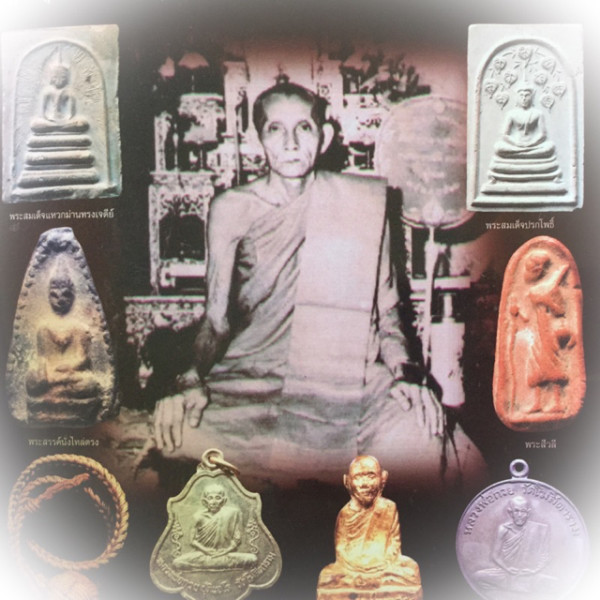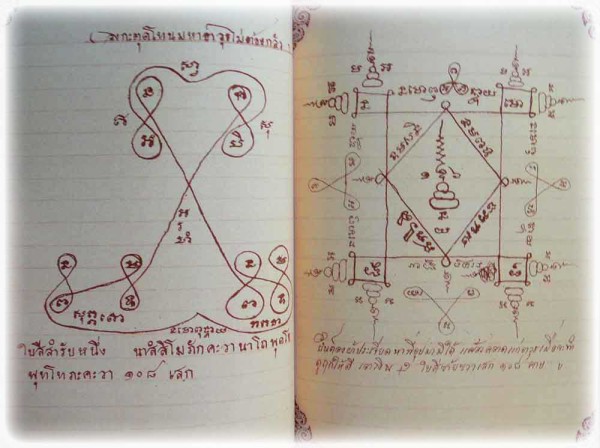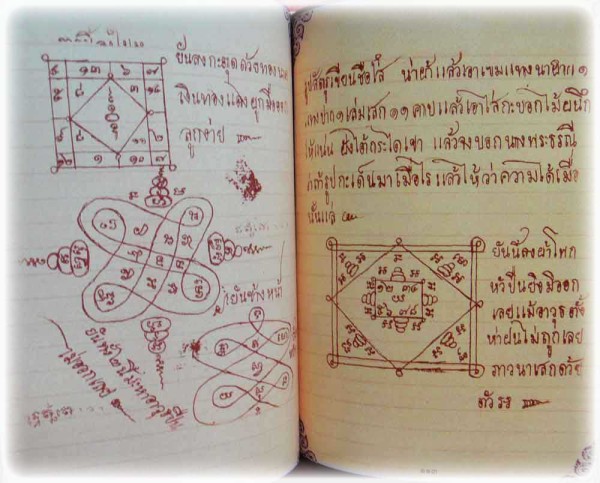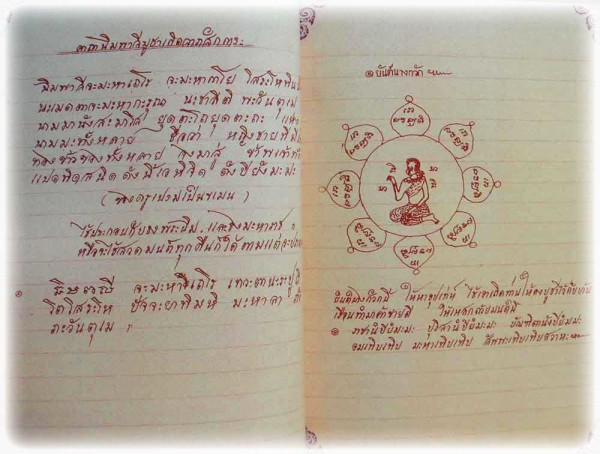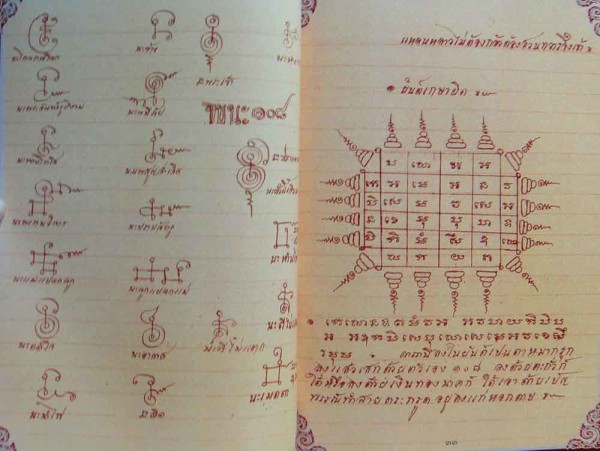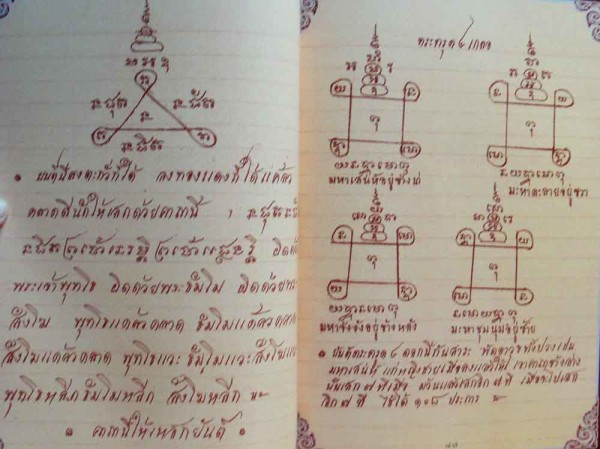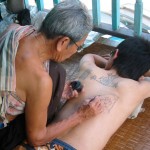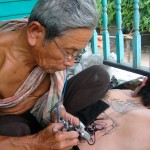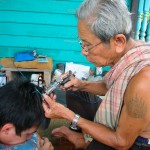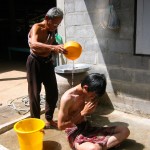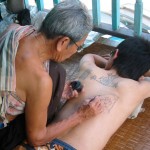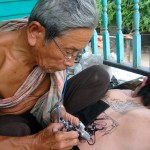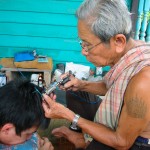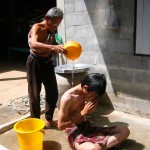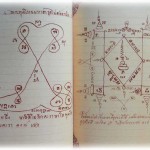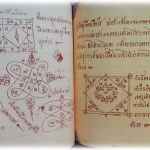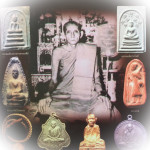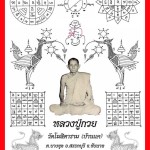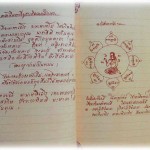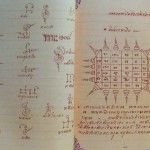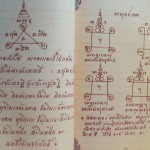A Portrait of Luang Por Guay – Sak Yant Master Gaeji Ajarn
During the Second World War, as Luang Por Guay returned to reside at Wat Kae and began to make Sak Yant on the Looksit of the temple. It has been documented from interviews with the older generation of Looksit of Wat Kae, some of whom were older than Luang Por himself, with ages of up to 90 years old, that Luang Por began tattooing Sak Yant at the age of around 35 years old up to the age of around 50 years old.
 When he made Sak Yant, he would write down the names of each of the Looksit who were to receive Sak Yant. He would write down both the name and address, and the Yant that was to be tattooed. He would then mark a sign by the names of those Looksit who had also already attended the Wai Kroo Ceremony. His Wicha was very famous in those days, and Luang Por would tattoo from mornings into the dark hours. In those days, there was no real Infrastructure worth mentioning, and it was necessary to go to the temple on foot, and was rather a difficult journey.
When he made Sak Yant, he would write down the names of each of the Looksit who were to receive Sak Yant. He would write down both the name and address, and the Yant that was to be tattooed. He would then mark a sign by the names of those Looksit who had also already attended the Wai Kroo Ceremony. His Wicha was very famous in those days, and Luang Por would tattoo from mornings into the dark hours. In those days, there was no real Infrastructure worth mentioning, and it was necessary to go to the temple on foot, and was rather a difficult journey.
The book of Luang Por Guay had over Fifty Five Thousand names of different Looksit, who had come to the temple for Sak Yant, which is an unimaginable quantity of tattoos for one monk to have made.
As Luang Por began to grow old, he became very weary and gave up Sak Yant. He did not however, stop his involvement in Buddha Magic, and began to make Buddha amulets and magical charms, such as Tagrud, Miid Hmor, and magic Armbands.
There was a great depression in Siam at that time, and many bandits were afoot, especially in the lower part of Central Thailand around Nakorn Sawan, Chaynat, Ang Tong, and Supannburi. These areas were the favorite refuge of the ‘Suea’ (Suea means ‘Tiger’ referring to fearless outlaws and pirates). The local folk of Ban Kae relied on the power of Luang Por Guay to protect their households and belongings from the wild highwaymen, and robbers.
Anything of value which the villagers had, they would bring and leave at the temple with Luang Por, even families would come to ask to sleep in the temple because they were afraid of the roaming Villains. People would wander into the temple with their cows and buffaloes to sleep on the temple lawns. From what the older generation in Ban Kae tell, it seems that the there was not a single bandit who dared to take Luang Por Guay on, for fear of his Magic Powers.
There was the case of a ‘Suea’ from Ang Tong, who brought his gang and encircled the temple in the darkness of night, seeing that the lawns of the temple had many cows and buffaloes to steal. But they were used for target practice by Luang Por, and eventually had to flee and never returned again, for it was always so that when bandits walked near to the temple grounds, Luang Por would give the welcome signal with a gun shot , and they would flee instantly.
Luang Por Guay was an Ajarn Sak who was very dedicated to the creation of authentic amulets using the ancient traditional Wicha. His Sak Yant did not have much Khom Agkhara lettering embellishing it at all, and were usually one single Yant. Sometimes small, or sometimes large enough to fill the whole back. Most Looksit would only come and get get Sak Yant once, or twice. At the most, three times would be the maximum that a Looksit would come to add.
His compendium would begin the composition as follows; the first Yant would be a Yant in the middle of the chest, and one more Yant on the back. If anyone wished for extra they could return and get more. If he laid more on, he would place Hanuman on the flank. If that wasn’t enough for them, he would add a tiger. But there were very few Looksit who ever got the tiger.
For receiving Sak Yant from Luang Por Guay, it was necessary to offer Hua Moo Bai Sri (pigs head and Bai Sri cone offering) and Wai Kroo first. His design pantheon included the following Yant;
Suea, Singh, Hanuman, Nok Insee (eagle), Ngoo Pan Daab (snake winding around a sword), Grao Paetch (Diamond Armour Yantra) on the head, Hongs birds on the shoulderblades, and ‘Yant Tanu Mer’ (Arrow Yantra on the hand). Few people would have enough stamina to receive all of these tattoos on their bodies (it seems that Luang Por Guays Sak Yant tattoos hurt a lot).
Apart from giving them a Sak Yant, he would give them some sesame oil to consume (about 2 or 3 spoonfuls each time). This sesame oil was special because Luang Por would constantly chant and bless it so often, until it became thick texture and scaly like flakes of ice. Only magicians with extreme power are able to chant oil to become solid with a Kata If eaten, the sensation of the sesame oil (‘Nam Man Nga’ in Thai) on the mouth and throat would linger for many days.
Luang Pors ‘Witii Bplug Saeg’ (method of spellcasting/empowering a sacred, or magical object), would insert ‘Akom’ magic, and use Yana to empower it.Luang Pors Yant were very powerful and would not ‘Sueam’ (fall into decay) regardless of whether the devotee would go sleep with someone or not or other forms of cajoling.
Excepting the rules which Luang Por laid down for Sak Yant, all other activities would not affect the magic, due to its strength and surety of balance. As they say – quality is better than quantity. He passed on the Wicha and the Lineage to some apprentices, such as Lung Tort, Lung Lon, and Ajarn Song. Luang Por Guay and these three Ajarn would make the Sak Yant tattoos, and Luang Por Guay would then chant the Kata and make the blessings for them.
After some years, Luang Por Guay gave up Sak Yant tattooing, and shortly after also stopped making the Chanting of the Spells, and left the job to the Looksit to take over the responsibility. They had completed their apprenticeship, and Luang Por was very old and not strong enough to withstand the physical strain of tattooing. Luang Por then turned to the creation of Buddhist amulets and magic charms, and continued making them until the end of his days.
It was quite common that many people who received Sak Yant from Luang Por Guays temple would experience cases of guns shot but the bullet not penetrating, be stabbed or bludgeoned but no skin breaks, or bruises. Those Looksit of Sak Yant from Luang Por, would always be well provided for and have enough sustenance in the Household. There were also various cases of Apiniharn (magical or miraculous events) in the Maha Ud magic (Gunstopper – the gun can not fire, and is silenced, paralyzed, ceases to function when pointed at a Looksit with Sak Yant). In truth, there are many Sak Yant around, but there are few which really have this special power to silence an inanimate object such as a pointed, loaded, fully functional gun. The more you investigate Thai Buddha Magic, the more you see that there are some things beyond explanation.
This article is a small Excerpt from the Biography of Luang Por Guay, to be published as one of the Chapters of ISSUE 4 OF ‘BUDDHA MAGIC EZINE, due out in mid February. Issue 4 also has much about sacred Yantra in the ‘Dtamra Pichai Songkram’ story, and one more biography of a Sak yant Master ; Luang Por Pratueang.
Looksit who continue the Lineage of Practice of Sak Yant of Luang Por Guay in the Present Era;
‘Dta Lon’ (Ajarn Lon Yaem Tap), who resides in front of Wat Kae temple, who once Ordained as a Bhikku and learned Wicha with Luang Por, as Luang Por Guay journeyed to see Luang Por Derm for the last time, Dta Lon and one other Looksit were the ones who traveled with him, and this is where the Wicha was learned.
- Luang Por Guay Sak Yant designs book
- Yant designs of the Grimoire of Luang Por Guay
- Luang Por Guay surrounded by some of his famous amulets
- Luang Por Guay Sak Yant design book pages
- Sak Yant Designs from the Grimoire of Luang Por Guay Wat Kositaram
- Luang Por Guay Grimoire of Sacred Geometry for Sak Yant Tattoos
